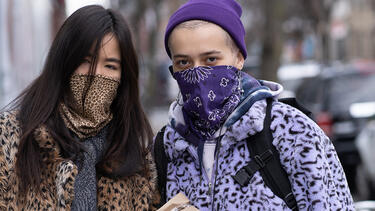Time to Put on a Mask
A team of Yale researchers looked at the evidence for whether ordinary people should wear masks to slow transmission of COVID-19. Their verdict: Yes, we should all be wearing cloth masks, but give the surgical masks to healthcare workers. We asked Yale SOM’s Jason Abaluck and Judith Chevalier, two of the co-authors, to explain the reasoning behind this recommendation.

Photo by Jared Siskin/Getty Images
Why do you recommend that everyone start wearing cloth masks?
The main reason to wear a mask is to protect the people around you. We have strong evidence both that 1) masks prevent infected people from transmitting the virus and 2) a lot of transmission is by asymptomatic people who don’t know they are sick. Even if you feel perfectly fine, you may be spreading the virus. If you wear a mask in public and you are one of those asymptomatic people, you are less likely to transmit the virus to others. This is absolutely not a substitute for social distancing, but is helpful in situations like going to the grocery store. If worn correctly and cleaned regularly, masks likely also help protect you somewhat from being infected.
Read the white paper: “The Case for Universal Cloth Mask Adoption & Policies to Increase the Supply of Medical Masks for Health Workers,” by Jason Abaluck, Judith Chevalier, Nicholas A. Christakis, Howard Forman, Edward H. Kaplan, Albert Ko, and Sten H. Vermund
How can we ensure medical workers get the protective masks they need?
We recommend that people wear cloth masks because there is a critical shortage of medical masks. For the moment (until there is no longer a shortage), N95 respirators and surgical masks should be donated to hospitals where they are inordinately more valuable.
More generally, the problem is that there are not enough medical masks to go around, even if reserved for health workers. The solution is to make more medical masks. The best way to do so is to heavily reward producers when they make and sell masks. This can be accomplished via large subsidies for each mask purchased. Concurrently, the government should use the Defense Production Act to directly produce medical masks at facilities that might not otherwise do so. But it is important to also reward private production. Incentivizing the private sector to produce masks serves three critical purposes: 1) they will produce more masks now, 2) they will invest in scaling up mask production capacity, which will save many lives as the pandemic spreads through the rest of the world, and 3) if mask producers know they will be heavily rewarded, they will be incentivized to produce a stockpile of masks for future pandemics. The value generated by each additional mask means it is almost impossible to go overboard in subsidizing the production of medical masks.
What data are you looking at to understand how masks might impact the spread of COVID-19?
Our analysis combines data from a variety of sources. The most compelling and direct data for the effectiveness of masks in preventing transmission comes from laboratory experiments that others have done, where one can see directly that masks reduce the amount of virus found in exhaled breaths. This is the reason that people who test positive for the virus have always been instructed to wear masks. That data alone does not tell us how much masks might slow the spread of the epidemic.
We also ask whether countries with pre-existing norms that people wear masks when sick have slower growth rates of cases and COVID-19 deaths. The idea is that in those countries, people are more likely to wear masks if they have only minimal symptoms but haven’t yet tested positive. We find that in those countries, the epidemic spread more slowly. This evidence is only suggestive as there are many other differences between countries besides masks. In South Korea, there was more testing. In Japan, handshakes are less common. We try to control for some policy differences but can’t control for everything. We see this as not dispositive but as one more piece of evidence suggesting that masks help slow the spread of the virus, which, when coupled with evidence from other sources, provides a very compelling case.
In our economic analysis, we adopt a more conservative stance. We ask what is implied if masks only reduce by 10% the likelihood that an infected person transmits the virus (even though our cross-country analysis suggests the impact might be much larger). Because the stakes are so large, even a 10% reduction implies $3,000-$6,000 in value per mask! This is because the epidemiological models suggest that so many people are at risk of becoming infected and dying. Even if we think those models overstate things by a factor of 10, cloth masks would still have at least $300 in value per person. The gains from universal adoption are extremely large no matter how you calculate them.